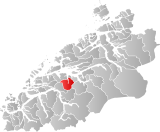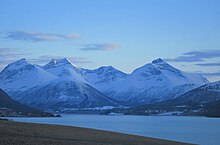Tresfjord
Tresfjord Municipality
Tresfjord herad Sylte herred (historic) | |
|---|---|
 Møre og Romsdal within Norway | |
 Tresfjord within Møre og Romsdal | |
| Coordinates: 62°31′14″N 07°07′23″E / 62.52056°N 7.12306°E | |
| Country | Norway |
| County | Møre og Romsdal |
| District | Romsdal |
| Established | 1 Jan 1899 |
| • Preceded by | Vestnes Municipality |
| Disestablished | 1 Jan 1964 |
| • Succeeded by | Vestnes Municipality |
| Administrative centre | Tresfjord |
| Area (upon dissolution) | |
| • Total | 200 km2 (80 sq mi) |
| Population (1964) | |
| • Total | 1,319 |
| • Density | 6.6/km2 (17/sq mi) |
| Time zone | UTC+01:00 (CET) |
| • Summer (DST) | UTC+02:00 (CEST) |
| ISO 3166 code | NO-1536[1] |
Tresfjord is former municipality in Møre og Romsdal county, Norway. The municipality existed from 1899 until its dissolution in 1964. It encompassed about 200 square kilometres (77 sq mi) in the southern part of the present-day Vestnes Municipality. The municipality included the Skorgedalen valley and the area surrounding both sides of the southern half of the Tresfjorden. The village of Tresfjord was the administrative centre of the municipality, and it was the location of Tresfjord Church, the main church for the municipality.[2]
History


The municipality of Sylte was established on 1 January 1899 when it was separated from Vestnes Municipality. The initial population was 1,408. The name was changed to Tresfjord on 28 April 1922.[3]
During the 1960s, there were many municipal mergers across Norway due to the work of the Schei Committee. On 1 January 1964, the municipality ceased to exist when it became a part of Vestnes Municipality once again. The population at that time was 1,319.[3]
Name
The municipality (originally the parish) was first named Sylte. This comes from the old Sylte farm (Old Norse: Sultar) since the first Sylte Church was built there. The name comes from the genitive case of the word sultr which means "hunger" or "famine", possibly referring to a swampy area near the farm that is not suitable for farming.[4]
In 1922, the municipality was re-named Tresfjord after the local fjord, Tresfjorden (Old Norse: Þræsir). The main village in the municipality was located at the head of the fjord and it was also named Tresfjord. The first element comes from the local river Tressa. This name is probably derived from the word træsa which means "to walk restlessly back and forth" or "to trot about". This likely refers to the strong current in the fjord. The last element is fjord which means "fjord".[5]
Government
While it existed, this municipality was responsible for primary education (through 10th grade), outpatient health services, senior citizen services, unemployment, social services, zoning, economic development, and municipal roads. During its existence, this municipality was governed by a municipal council of directly elected representatives. The mayor was indirectly elected by a vote of the municipal council.[6]
Municipal council
The municipal council (Heradsstyre) of Tresfjord was made up of representatives that were elected to four year terms. The party breakdown of the final municipal council was as follows:
| Party name (in Nynorsk) | Number of representatives | |
|---|---|---|
| Labour Party (Arbeidarpartiet) | 4 | |
| Christian Democratic Party (Kristeleg Folkeparti) | 2 | |
| Centre Party (Senterpartiet) | 6 | |
| Liberal Party (Venstre) | 1 | |
| Total number of members: | 13 | |
| Party name (in Nynorsk) | Number of representatives | |
|---|---|---|
| Labour Party (Arbeidarpartiet) | 5 | |
| Christian Democratic Party (Kristeleg Folkeparti) | 2 | |
| Farmers' Party (Bondepartiet) | 5 | |
| Liberal Party (Venstre) | 1 | |
| Total number of members: | 13 | |
| Party name (in Nynorsk) | Number of representatives | |
|---|---|---|
| Labour Party (Arbeidarpartiet) | 4 | |
| Farmers' Party (Bondepartiet) | 5 | |
| Liberal Party (Venstre) | 3 | |
| Total number of members: | 12 | |
| Party name (in Nynorsk) | Number of representatives | |
|---|---|---|
| Labour Party (Arbeidarpartiet) | 4 | |
| Farmers' Party (Bondepartiet) | 8 | |
| Total number of members: | 12 | |
| Party name (in Nynorsk) | Number of representatives | |
|---|---|---|
| Labour Party (Arbeidarpartiet) | 4 | |
| Farmers' Party (Bondepartiet) | 5 | |
| Liberal Party (Venstre) | 3 | |
| Total number of members: | 12 | |
| Party name (in Nynorsk) | Number of representatives | |
|---|---|---|
| Labour Party (Arbeidarpartiet) | 5 | |
| Farmers' Party (Bondepartiet) | 4 | |
| Liberal Party (Venstre) | 3 | |
| Total number of members: | 12 | |
| Note: Due to the German occupation of Norway during World War II, no elections were held for new municipal councils until after the war ended in 1945. | ||
See also
References
- ^ Bolstad, Erik; Thorsnæs, Geir, eds. (26 January 2023). "Kommunenummer". Store norske leksikon (in Norwegian). Kunnskapsforlaget.
- ^ Store norske leksikon. "Tresfjord kommune" (in Norwegian). Retrieved 3 June 2013.
- ^ a b Jukvam, Dag (1999). Historisk oversikt over endringer i kommune- og fylkesinndelingen (PDF) (in Norwegian). Statistisk sentralbyrå. ISBN 9788253746845.
- ^ Rygh, Oluf (1908). Norske gaardnavne: Romsdals amt (in Norwegian) (13 ed.). Kristiania, Norge: W. C. Fabritius & sønners bogtrikkeri. p. 211.
- ^ Thorsnæs, Geir, ed. (28 December 2022). "Tresfjord (tettsted)". Store norske leksikon (in Norwegian). Kunnskapsforlaget. Retrieved 6 April 2023.
- ^ Hansen, Tore; Vabo, Signy Irene, eds. (20 September 2022). "kommunestyre". Store norske leksikon (in Norwegian). Kunnskapsforlaget. Retrieved 1 January 2023.
- ^ "Kommunevalgene og Ordførervalgene 1959" (PDF) (in Norwegian). Oslo: Statistisk sentralbyrå. 1960. Retrieved 20 April 2020.
- ^ "Kommunevalgene og Ordførervalgene 1955" (PDF) (in Norwegian). Oslo: Statistisk sentralbyrå. 1957. Retrieved 20 April 2020.
- ^ "Kommunevalgene og Ordførervalgene 1951" (PDF) (in Norwegian). Oslo: Statistisk sentralbyrå. 1952. Retrieved 20 April 2020.
- ^ "Kommunevalgene og Ordførervalgene 1947" (PDF) (in Norwegian). Oslo: Statistisk sentralbyrå. 1948. Retrieved 20 April 2020.
- ^ "Kommunevalgene og Ordførervalgene 1945" (PDF) (in Norwegian). Oslo: Statistisk sentralbyrå. 1947. Retrieved 20 April 2020.
- ^ "Kommunevalgene og Ordførervalgene 1937" (PDF) (in Norwegian). Oslo: Statistisk sentralbyrå. 1938. Retrieved 20 April 2020.

